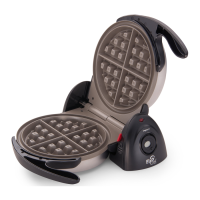2
Wafe grids
Signal light
Fig. A
Hinged base
Red locking lever
Fig. B
Fig. C
Fig. D
Fig. E
Important Cord Information
This appliance has a polarized plug (one blade is wider than the other). To reduce the risk of electric shock, this plug is intended to t
into a polarized outlet only one way. If the plug does not t fully into the outlet, reverse the plug. If it still does not t, contact a qualied
electrician. Do not attempt to modify the plug in any way.
A short power supply cord is provided to reduce the risk of becoming entangled in or tripping over a longer cord. Extension cords may
be used if care is properly exercised in their use.
If an extension cord is used, the marked electrical rating of the extension cord should be at least as great as the electrical rating of the
appliance. The extension cord should be arranged so that it will not drape over the countertop or tabletop where it can be pulled on by
children or tripped over unintentionally.
Connect the power supply cord to a 120VAC electrical outlet only.
Getting Acquainted
Before using for the rst time, become familiar with the wafe maker features
(Fig. A). Wipe the wafe grids with a damp cloth before initial use.
How to Use
1. Place the closed unit on the countertop so the signal light is facing you (Fig. C).
Plug the cord into a 120VAC electrical outlet and preheat the wafe maker in the
closed position. The signal light will glow (Fig. A). When the unit has reached
the correct temperature, the light will go out indicating the unit is ready for use.
Preheat time is short—approximately 3 to 5 minutes. During cooking, the light
will go on and off indicating temperature is being maintained.
NOTE: When using the wafe maker for the rst time, a slight odor or smoking
may occur as manufacturing residue burns off. This is normal during initial use.
2. While unit is preheating, prepare wafe batter.
NOTE: Because the grids are covered with a ceramic nonstick nish, there should be no need to apply
vegetable oil. No-stick cooking sprays are not recommended.
3. Pour approximately ¾ to 1 cup wafe batter into the center of the bottom wafe grid (Fig. B). The
amount of wafe batter needed may vary with the recipe or brand of batter mix used. If using the recipes
in this booklet (pages 4 through 6), refer to them for the recommended amount of batter.
4. See the recipes on pages 4 through 6 for cooking times. Most wafe recipes will take about 4 minutes.
Set a timer for the recommended time.
5. Close the wafe maker (Fig. C). While grasping both handles, ip the unit over 180° (Fig. D and Fig. E).
6. When the set time has expired, open the wafe maker. Using a fork, spear the side of the wafe and
lift it from the grids.
7. Repeat steps 3 through 6 for additional wafes.
8. Unplug wafe maker when cooking is completed.
Helpful Hints
♦ If desired, packaged wafe mixes may be prepared and baked in the Presto
®
wafe maker. Batter made
from some packaged mixes may have a shorter baking time, so it is recommended that you check for
doneness after 2 minutes. A good indication that the wafe is done is when steam escaping from the
wafe maker stops.
♦ Wafe batters, whether using mixes or homemade recipes, will vary and therefore the amount of batter
needed for an evenly lled wafe, without overow, will vary. It is recommended that when making the
rst wafe you use a measuring cup to gauge how much batter is needed. Generally between ¾ and 1
cup works best. Never use more than 1 cup of batter. If you get some overow, be sure to use less batter
for the next wafe.
♦ For batters that don’t ow when poured onto the wafe grid, use a heat-resistant spatula and spread out
the batter evenly to the edges of the grid.

